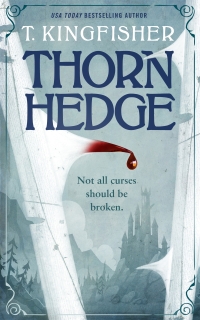
I have a lot of mixed thoughts about T. Kingfisher’s “Thornhedge.” On the one hand, there are a lot of super interesting ideas at play here. The whole thing is very “Maleficent” meets Neil Gaiman’s “Snow, Glass, Apples.” And that’s a very cool direction to take a “Sleeping Beauty” retelling. But on the other hand, I’m not entirely sure all of the novella’s elements fully come together as a satisfying whole. It’s a sweet, horrific, enticing read that’s as slow-paced and occasionally frustrating as it is thrilling. A fairy tale in the truest sense of the word, but also a story with a lot of missed opportunities.
T. Kingfisher’s “Thornhedge” retells the story of “Sleeping Beauty” from the perspective of the fairy imprisoning the maiden. Except, it’s a little bit more complicated than that. For this is a world filled with changelings and fae folk and sea monsters and reanimated corpses. A world that’s equal parts horrific and beautiful. And our fairy, Toadling, rests exactly in the middle of this strange cross-section. Kingfisher’s gift for world-building is on full display here as she quickly and effectively builds this twisted, magical world around Toadling. However, that world-building proves to be both the novella’s greatest strength and its biggest weakness.
“Thornhedge” feels like a story that’s trying to do too much with too little. It takes forever for the story to get going because it has to introduce all of these disparate elements. As a result, you’re nearly halfway through the book before it fully captures your attention. And at that point, you look at how many pages are left and wonder how on earth there’s gonna be enough time to give everything that’s set up a chance to truly shine. It’s also around that point where it becomes obvious that “Thornhedge” is Toadling’s story and not the sleeping beauty’s – and, as such, it’s a character-driven piece and not a plot-driven one.
Now, this decision proves to be a true boon for the novella. Toadling’s growing relationship with Halim, the knight who initially hopes to save the sleeping maiden, is easily the best aspect of the story. Kingfisher fills these scenes with all the classic romantic tropes you could hope for. And it’s just so sweet – in the best way possible. That sweetness helps soften the undercurrent of darkness that wades throughout the story. At its heart, “Thornhedge” is a story about hope and forgiveness, not about monsters and darkness and hopelessness. And there’s a lot to love about that.
On the flip side, the book’s hyperfocus on Toadling’s character journey results in the overarching plot feeling quite rushed – especially at the end. No spoilers here, but I think it’s safe to say that things get wrapped up far too quickly and far too easily. This is where I think the book’s page count hurts it. Another hundred pages or so could’ve easily given the story some time to breathe. More room for Toadling and Halim to get to know each other, to feel more fully rounded as people, and more room for the plot to be explored as in-depth as it’s clearly craving to be. For some, this won’t be much of an issue. But I found myself wanting a whole lot more, in a way that hindered my enjoyment.
At the end of the day, “Thornhedge” is a mixed bag. A collection of super interesting ideas all executed a bit unevenly. The novella works more often than it doesn’t, to be fair. But in those moments it doesn’t work, it really doesn’t work. Longtime fans of Kingfisher’s writing might not be bothered by this. But it struck me a bit. I like the idea behind “Thornhedge“, I love Toadling as a character, but the story itself just didn’t quite gel for me. It’s gonna be some people’s fantasy, for sure. But I’m not sure it was mine.
3.5 out of 5 wands
NOTE: A review copy was provided by Edelweiss and Tor Books in exchange for a fair review. All thoughts are my own.
